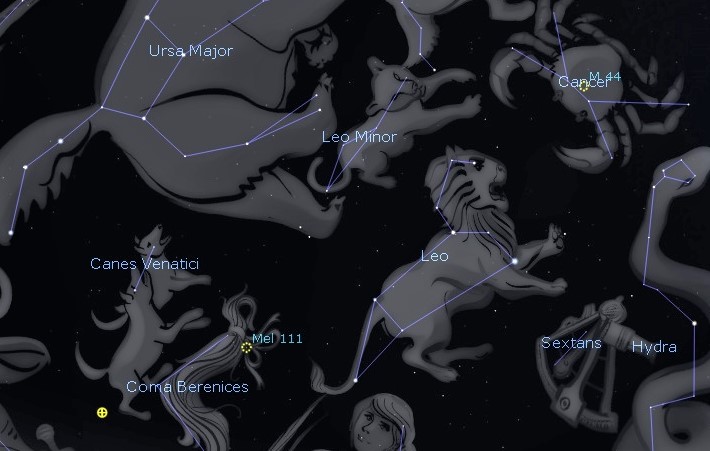This Week’s Sky at a Glance, 2023 February 18 – February 25~

This Week’s Sky at a Glance, 2023 February 18 – February 25~
Winter is open cluster season for stargazers. They are also called galactic clusters because they form in the spiral arms of our galaxy. In winter we are looking toward a spiral arm opposite the centre of our Milky Way galaxy. Two such clusters, the Pleiades (M45) and the Hyades, form the shoulder and face of Taurus the Bull and they are bright enough to be seen within urban areas. Other clusters are visible to the naked eye but require a clear sky with minimal light pollution.
One of these is the Beehive cluster (M44) in the constellation Cancer the Crab, which lies between Gemini and Leo. The Beehive resembles a large glowing patch of haze to the eye and its many stars fill the view in a telescope, but large clusters like this are appreciated best with binoculars. In times long past the cluster was used as a storm predictor as it would be one of the first objects to disappear when the light clouds that precede a weather system would move in.
The Coma star cluster, or Melotte 111, lies in Coma Berenices between the tail of Leo and Canes Venatici. It is a large, somewhat sparse cluster that spills beyond the view of most binoculars, and centuries ago it was regarded as the tuft of Leo’s tail. Another one, or two, is the Double Cluster between Perseus and Cassiopeia. This pair fits within the view of a low power telescope eyepiece, but binoculars give a better perspective. Following a nearby string of stars with binos will bring you to the large Stock 2 star cluster, less spectacular but delightful to observe.
This Week in the Solar System
Saturday’s sunrise in Moncton is at 7:17 am and sunset will occur at 5:49 pm, giving 10 hours, 32 minutes of daylight (7:21 am and 5:55 pm in Saint John). Next Saturday the Sun will rise at 7:05 am and set at 5:59 pm, giving 10 hours, 54 minutes of daylight (7:09 am and 6:05 pm in Saint John).
The Moon is new and near perigee on Monday, resulting in extreme tides early in the week. The Moon will be below Venus on Tuesday and near Jupiter Wednesday. Watch speedy Venus close the gap to Jupiter over the rest of the month. Mars inches between the horns of Taurus, highlighting a red triangle with Aldebaran and Betelgeuse. Mercury is heading toward a morning meet-up with Saturn at the end of the month but they will be too close to the Sun for observing. Comet E3 ZTF fades as it spends the rest of the month sliding to the western side of Orion’s shield, and a telescope is recommended to observe it.
On Sunday evening at 8 pm, tune in to the Sunday Night Astronomy Show via the Facebook page or YouTube channel of Astronomy by the Bay.
Questions? Contact Curt Nason at Curt Nason
